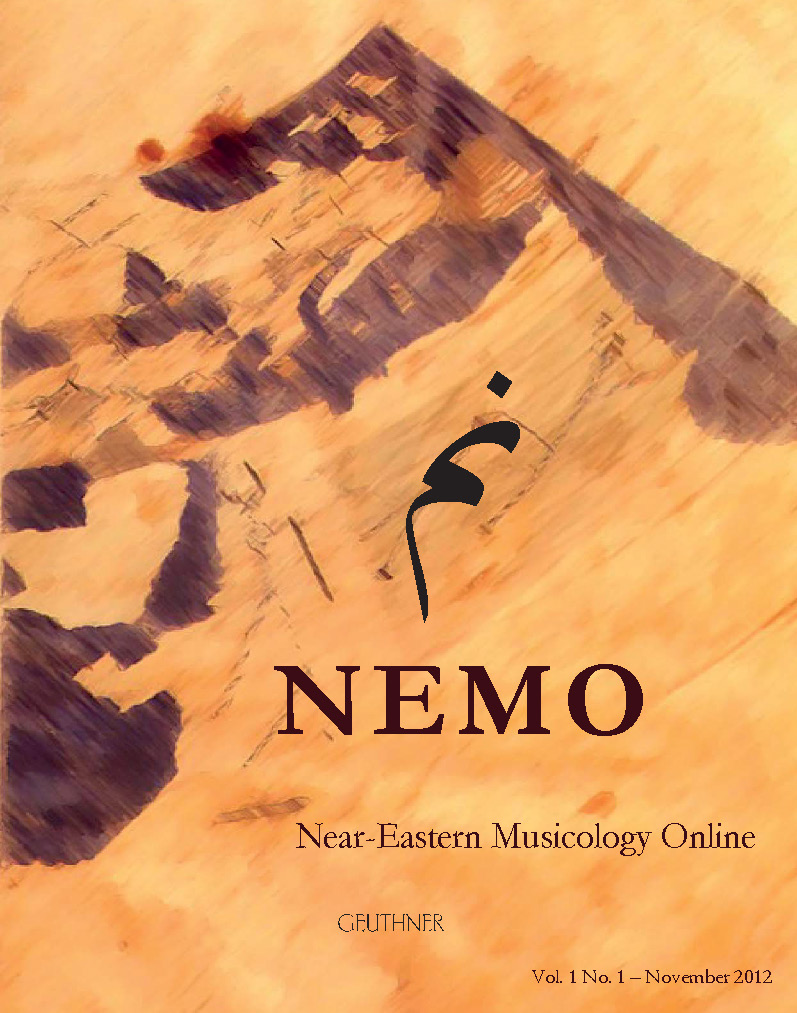Theme: ‘Questioning Modality’ – “La modalité en question”
The theme for the forthcoming issue of NEMO-Online (VOL. 1) is ”Questioning Modality’ or, “La modalité en question“. Contributions welcome in English, German, French and Arabic. Please email by end of November 2011 to Richard Dumbrill (rdumbrill[[[]]]nemo-online.org) and Amine Beyhom (abeyhom[[[]]]nemo-online.org).
Click here for guidelines
Please read the discussion below, in English or in French, as well as recent postings (French), referencing guidelines. Please download the transliteration guidelines for the Arabic language prior to sending your paper.
Discussion (English) :
Winnington-Ingram’s definition (Mode in Ancient Greek Music, Cambridge University Press 1936) is a classic:
Mode is essentially a question of the internal relationships of notes within a scale, especially of the predominance of one of them over the others as a tonic, its predominance being established in any or all of a number of ways: e.g., frequent recurrence, its appearance in a prominent position as the first note or the last, the delaying of its expected occurrence by some kind of embellishment.
Other definitions, mostly influenced by Ancient Greek philosophy or by Indian music ragas, introduce the concept of ‘ethos’, or may emphasize internal balance between the pitches of the scale. There is also much confusion about the perception of “mode” and “maqām“, or with any other terms, for a particular culture, a melodic construction the characteristics of which being akin to Winnington-Ingram’s definition.
However, a series of disturbing questions are raised: does mode really exist (Harold Powers, ‘Is mode real? Pietro Aron, the octenary system, and polyphony,’ 1992) ? Is mode an intellectual construct of the West (Harold Powers, ‘Modality as a European cultural construct,’ 1992) similar to the construction of ’Folk Music’ versus ‘Art Music”‘ (Matthew GELBART, The Invention of ‘Folk Music’ and ‘Art Music’, Cambridge University Press, 2007) ? Can the term ‘mode’ have a single definition, from Ancient to Contemporary Music, from Scotland and Brittany to Iran, India and the Arabian Peninsula ? Is tonality related to modality, and how can they be defined ? And what is the role, if any, of formulation in modal construction ?
Technical problems arise, such as mode versus pentatonism; defining its boundaries; where does it begin, where does it end, and does mode influence the music or reciprocally whenever they meet ? Is mode relevant to non octavial scales and to the construction of scales with genera ? Are modality and temperament compatible ?
Although modality is widely used in musical discussions, no definition is yet satisfactory.
This first issue will concentrate on non Western mediaeval or polyphonic modality, including papers dealing with the modality of Western Folk music.
Discussion (French) :
La définition du mode par Winnington-Ingram (Mode in Ancient Greek Music, Cambridge University Press 1936) est considérée comme un classique :
Mode is essentially a question of the internal relationships of notes within a scale, especially of the predominance of one of them over the others as a tonic, its predominance being established in any or all of a number of ways: e.g., frequent recurrence, its appearance in a prominent position as the first note or the last, the delaying of its expected occurrence by some kind of embellishment.
D’autres définitions, peut-être influencées par les descriptions de musiques de l’Inde ou encore par la philosophie grecque, intègrent le concept de l’”éthos” dans cette définition, ou peuvent insister sur un équilibre interne entre les degrés de l’échelle ; par ailleurs, certaines conceptions confondent “mode” avec “maqām” ou avec tout autre terme se rapportant à une musique dont les caractéristiques sont proches de celles décrites par Winnington-Ingram.
Ces définitions appellent plusieurs questionnements, dont ceux concernant l’existence même de la modalité (Harold Powers, “Is mode real? Pietro Aron, the octenary system, and polyphony,” 1992) et son introduction dans la réflexion sur la musique (Harold Powers, “Modality as a European cultural construct,” 1992), avec un parallélisme possible, sinon probable, entre cette construction et celle du concept de musique “folk”, en opposant celle-ci à la musique dite “d’art” (Matthew GELBART, The Invention of “Folk Music” and “Art Music”, Cambridge University Press, 2007).
D’autres questions peuvent être posées : peut-on se contenter d’une définition unique du mode, notamment pour des musiques s’échelonnant de l’Antiquité jusqu’à nos jours, et se déployant dans une aire géographique qui va de l’Écosse et de la Bretagne jusqu’à l’Iran, l’Inde et la Péninsule arabique ? La “tonalité” est-elle liée à la “modalité”, et comment ? La modalité influence-t-elle d’autres musiques, et est-elle influencée par elles, et comment ? Quel est le rôle de la formularité dans la modalité ? Des maqām supposés être pentatoniques, ou basés sur une structure pentatonique, peuvent-ils être des “modes” ? Peut-on toujours parler de modalité dans le cas de structures non-octaviantes, ou encore basées sur des constructions scalaires en genres ? Modalité et tempérament sont-ils compatibles ? etc.
Toutes ces questions montrent que les concepts de “mode” et de “modalité”, bien que largement répandus, sont encore à préciser.
Le premier numéro se concentrera sur la modalité hors Occident médiéval ou polyphonique, mais incluant les musiques traditionnelles européennes.

